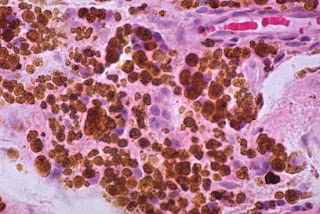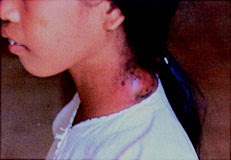Biology concepts – iron, genetic disease, infectious disease, immune evasion
Believeit or not, someone you know is rusting - and it probably saved his/her ancestor’s life.
Animals require iron to survive; normal adult humans carry about 3.5-4 grams of iron in their bodies. It’s vital for every cell. Red blood cells use iron as part of the hemoglobin molecule that carries oxygen, But all other cells use iron in part of electron transport chain that makes ATP, and in the synthesis of DNA.
In plants, iron is used in chlororphyll production, in nitrogen fixation, and in regulation of transpiration (moving water and nutrients up to the leaves). Plants are a decent source of dietary iron, but heme iron (from meat) is much more easily absorbed.
In both plants and animals, the amount of iron is highly regulated. Iron is most often bound to proteins; one type in cells, another in the blood, and they lock it up tight. When you need more, your gut cells (enterocytes) release some of their stored iron and then take in more from the food you eat.
People who absorb too little iron (from poor diet or absorption defects) have a hard time carrying oxygen to their tissues because they don’t have enough hemoglobin. They are fatigued, dizzy, lose their hair, and less able to fight off infections. Weirdly, they may demonstrate pagophagia; a compulsion to eat ice! The reason for this is open for discussion, but one hypothesis says there is an ancient crunching desire, related to chewing on bones to get at the iron-rich marrow.
Too little iron keeps you sick - and apparently always refilling the ice tray. But too much iron is just as bad; both ends of the scale can kill you.
Hereditary hemochromatosis (HH) is an autosomal recessive (need two mutated copies) disease of iron storage and transport. Patients with this disease may have as much as 20-40 grams of iron in their bodies; they can even set off metal detectors at airports!
All this iron causes medical problems too. People with HH will accumulate iron in their liver, heart, skin and other tissues. Excess iron plus fats can produce free radicals and oxygen radicals. The radicals can react with many molecules, including those you need in order to keep your cells functioning properly.
Radicals can break down enzymes, destroy mitochondria, and even react with the iron itself to produce iron oxide – rust; biological rust being called hemosiderin. Could HH patients be like the frozen Tin Man that Dorothy finds in the Wizard of Oz? Of course not, tin doesn’t rust – it’s a good thing L. Frank Baum was a writer and not a metallurgist!
Over time, the damage from free radicals and from hemosiderin buildup causes systems to shut down. Without treatment HH is lethal - so it is important to know how all that iron gets there.
We said above that enterocytes are the storage area for iron absorbed from your diet. In HH, the export signal is broken and they keep dumping their stored iron into the bloodstream. Even worse, the enterocytes lose the ability to sense if the body needs more iron. As a result of HH, gut cells keep absorbing more iron and releasing it into the bloodstream.
It’s a bad thing to inherit hemochromatosis…..EXCEPT if Yersinia pestis is lurking in the environment. Y. pestis is the bacterium that causes the plague. The organism can be passed from person to person, but also from fleas to people, and from fleas to animals to people.
You can read about how Y. pestis ensures it is transmitted to a new host from the flea’s midgut, but for reasons of decorum, I won’t go into it here. And I suggest you don’t eat before you read about it.
Y. pestis plague comes in three flavors; septicemic(travels through the blood), bubonic(causing swellings), and pneumonic(some organisms go to the lungs). In the case of pneumonic plague, coughing promotes transmission from person to person and is more lethal. But bubonic plague is more painful.
The plague has been a killer throughout human history, but Y. pestis’ relationship to the flea is evolutionary rather new. About 20,000 years ago, Yersinia killed the flea as well. According to new research, it took relatively few genetic changes to allow plague bacteria to keep the flea alive and to survive in its midgut. It was at this point that humans' trouble really began. It is estimated that a third of the population of Europe was lost to plague in 14th century. The infection still occurs today, but is highly treatable with antibiotics. Your immune system has problems getting rid of Y. pestis on its own.
Normally, your immune system recognizes foreign organisms and eliminates them, through either innate or adaptive mechanisms. However, Y. pestis has several tricks up itsleeve to avoid recognition and destruction by your immune system.
Immune cells can circulate in your blood, move in and out of your tissues, or may be located in your lymphatic system. In the lymph nodes, they gather to exchange information, like workers gossiping around the water cooler. If an antigen processing immune cell (APC) has encountered a foreign antigen, the APC will break it down and place pieces of the antigen on its surface, so the antigen can stimulate other immune cells.
The processed antigen is presented to the many types of immune cells in and moving through the lymph nodes, including B cells that make antibodies, and T cells that direct immune responses or directly kill organisms. This quickly increases an immune response; one cell encounters the invader, but by going to a central location (lymph node), thousands of cells can be stimulated.
Amazingly, Y. pestisactually lives and reproduces in your lymph nodes! The painful swellings in bubonic plague are the inflamed lymph nodes where the organism is reproducing. Each swollen node is called a buboe, hence the name of the plague. Buboes occur most commonly in the armpit (axilla), on the neck, or in the groin area – not a pleasant way to spend a weekend - maybe your last weekend.
The lymph nodes are the headquarters for stimulating immune responses, yet the Y. pestis lives here very happily. It manages this through several evasion mechanisms:
1) antiphagocytic proteins– Y. pestis can inject proteins into phagocytic cells that makes them poor at eating and killing. These proteins also makes immune cells unable to signal other immune cells that Y. pestis is there.
2) invasion proteins – plague bacteria can avoid immune detection by living insideseveral different host cell types; the macrophage is the major example.
3) survival proteins– Y. pestis can live inside the macrophages that are supposed to destroy them by turning off macrophage killing mechanisms.
4) heme stealing proteins– Y. pestis can steal iron from the host. And here is where HH comes in.
Hereis an organism that is perfectly happy living inside and in the company of the cells that are supposed to kill it - we’re doomed. Yet having a disease like hemochromatosis can save us. How can that be? Well, microorganisms need iron too. For much the same reasons as animals and plants, bacteria and other microorganisms must have a supply of iron. They may get it from their diet, or, as is the case with Y. pestis, they steal it from their host.
I can hear what you're saying - this doesn’t seem to make sense since HH results in lots of iron in cells. True, but there is an exception. HH leaves two cell types starved for iron - the enterocyte, which we already know about, and the macrophage. The reason for iron-poor macrophages during hemochromatosis is not completely understood, but one possibility is that the HH mutation affects macrophages the same way it affects enterocytes.
One important function of macrophages is to eat and destroy old host cells, including erythrocytes. The iron of the hemoglobin from all those degraded RBC’s is stored and recycled; this is an important mechanism that the body uses to reuse the iron it already has. But in HH, the macrophages may be pumping out the iron they take up from old RBCs, just as the enterocytes keep pumping out the iron they take up from the gut contents.
The iron-poor macrophage essentially starves the intracellular plague bacteria by not providing them with iron. This is a happy accident for us, but it isn’t as if the macrophage doesn’t already know this trick. Iron can be an important immune weapon. In mycobacterial infections (that cause pneumonia), macrophages actually raise the iron concentration in the ingested bacteria and kill them that way. In other infections, macrophages sequester their iron and starve the organisms.
Macrophageiron manipulation is not a natural immune response to Y. pestis, but HH helps to bring about the same effect, and this makes HH valuable. It is believed that many survivors of the plague in the 12ththrough 15th centuries had hemochromatosis. What is more, the gene is present in as many as 1/3 of living people of European descent, meaning that HH is probably massively underdiagnosed. It is likely that you know someone with HH, whether they not it or not.
Natural selection kept this mutation in the gene pool because it presented a reproductive advantage in times of plague. With antibiotics, we probably do not need this mutation any longer, but it is here and will take quite a while to be bred out of the population, especially since HH treatments (like bleeding, see the picture at right) help people live with the disease long enough to pass on their genes.
There are more examples of bad genes saving us from disease, like chemokine receptor mutations preventing HIV infection and aldehyde dehydrogenase mutations discouraging alcoholism. But next week we will focus on immune systems run amok and how parasites can reel them in.
Chouikha I, Hinnebusch BJ. (2012). Yersinia-flea interactions and the evolution of the arthropod-borne transmission route of plague. Curr Opin Microbiol. DOI: 10.1016/j.mib.2012.02.003
For more information or classroom activities, see Survival of the Sickest, by Dr. Sharon Moalem, or the following sites:
Iron in biochemistry –
Hereditary hemochromatosis –
Y. pestis plague –
Immune evasion strategies –
http://www.genengnews.com/gen-news-highlights/researchers-discover-how-some-pathogens-evade-the-immune-system/81243811/




